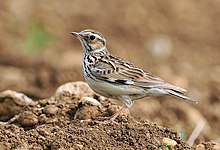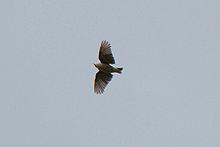Woodlark
| Woodlark | ||||||||||||
|---|---|---|---|---|---|---|---|---|---|---|---|---|

Woodlark ( Lullula arborea ) |
||||||||||||
| Systematics | ||||||||||||
|
||||||||||||
| Scientific name | ||||||||||||
| Lullula arborea | ||||||||||||
| ( Linnaeus , 1758) |
The woodlark ( Lullula arborea ) is a species of bird from the lark family (Alaudidae). This small species of lark inhabits the southwestern Palearctic from England and Portugal to the northwest of Iran and Turkmenistan . It mainly lives in sunny open areas in or on the edge of forests. The species is a moderately common breeding bird in Central Europe and spends the winter in southwestern Europe and the northern Mediterranean .
features
The woodlark has a body length of 13.5 to 15 cm and is therefore significantly smaller than the better-known skylark , the tail is noticeably short. The base color of the top is dull light brown. For this reason, the top of the head and the upper back are finely striped light beige and dark lengthways, the rump is monochrome brown. The wings are dark gray-brown. The large hand covers are white at the base, wide black in the middle and yellowish white at the tip and form a mark on the wing that is clearly visible when the bird is seated. The tail is gray-brown, the tips of the third to fifth control feathers , counted from the inside out, have a small white point, the outermost (sixth) control pen is lightened whitish brown at the end.
The species shows a strong, light over-eye stripe , the two over-eye stripes combine in a V-shape at the back of the head. On the back of the head, a fine dark gray line borders the outer eye strip below, which then runs along the lower edge of the eye to the beak angle and also delimits the ear covers in front. The ear covers are strong reddish brown and lighter towards the front. The beard stripe is broadly white, the chin stripe is also dark gray, the throat is white. The upper breast is finely light beige and dark longitudinally striped on a whitish background, the rest of the belly and the flanks are white.
The legs are yellowish-brown to flesh-colored, the slender beak is brown-gray and lightened at the base.
Vocalizations
The melodic singing is performed mainly from a singing flight, less often and then shorter from the floor or from waiting. It is soft and melodic and consists of rows of short syllables that follow each other slowly at the beginning, then faster and faster, and then get louder and deeper at the end of the stanza. There is a pause after each stanza. The chant can be rendered like “li, li-li-lililiLÍlülü… ÍÍ-lü ÍÍ-lü ÍÍ-lü-ÍÍlu-ÍÍluÍÍlu” etc. Migrants shout "TLUii-TLUii" softly.
distribution and habitat
The distribution area of the woodlark covers large parts of the south-western Palearctic from England and Portugal to the north-west of Iran and Turkmenistan . The northern limit of the distribution of this relatively warm species runs in Europe through the south of England, the south of Scandinavia and Finland and further east through Karelia and central Russia. In the south the distribution extends to North Africa, Cyprus , Israel, to the north of Syria and the north-west of Iraq . It mainly inhabits sunny, dry open areas in or on the edge of forests such as clearcuts, burned areas and wide aisles, but also heaths, the edge zones of moors and orchards. Important habitat elements are low grassy vegetation less than 5 cm in height and areas free of vegetation for foraging and sitting areas in the form of bushes or trees. In Sauerland breed woodlarks in the 18,000 hectares of Christmas trees . In 2017, 400 breeding pairs were found in the Hochsauerlandkreis alone , while otherwise only five pairs breed in heaths there.
nutrition
The diet consists of both animal and vegetable components. In summer mainly invertebrates of all kinds and seeds are eaten, in spring mainly freshly sprouting grasses, small leaves and buds.
Reproduction
The nest is hidden in the vegetation on the ground. It consists of plant material that becomes finer and finer towards the inside, the hollow is lined with fine roots. In Central Europe, eggs are laid around March 20 at the earliest, usually from late March to early April. Second broods are rare in Central Europe, but appear regularly in Southern Europe. The clutch consists of 2–7, mostly 3–6 eggs, which are very fine and dense brownish dots on a whitish background. The breeding season lasts 13–15 days. The incubation is carried out exclusively by the female; the nestlings are also only hovered by the female up to the age of 5–8 days, but then fed by both parents. The young birds can walk with 7 days and fly short distances with 12 days, after 16 days they are fully fledged.
hikes
The woodlark is predominantly short-distance migrant in Central, Eastern and Northern Europe . The withdrawal from the breeding areas takes place from mid-September and lasts until the end of October or early November with the last stragglers in December. The birds overwinter mainly in western France, on the Iberian Peninsula and in the northern Mediterranean area, but there are individual winter records from almost all of Central Europe to Poland and the Czech Republic, and rarely even in southern Scandinavia. The home migration through Central Europe takes place from mid-February, the breeding grounds are mostly occupied until the end of March.
Existence and endangerment
There is no reliable information on the world population ; the IUCN gives a rough estimate for the European population of 2.5–6.5 million individuals. According to the IUCN, the species is not endangered.
In large parts of Germany, the species has been declining since the beginning of the 20th century. Since the 1960s, the stock has decreased, in some cases drastically, and in some cases it has fallen to a fraction of the previous figures. On the other hand, local populations increased on clearcuts, windthrow and forest fire areas, on nutrient-poor arable land and on debushed and re-grazed sheep pastures, as well as training areas in dry, sandy areas.
Varia
- With reference to the woodlark and their singing skills by name, four young girls appeared as Schmannewitzer Heidelerchen in their parents' Café Jacob , before they later became known nationwide as Jacob Sisters .
swell
Individual evidence
- ^ Lars Svensson, Peter J. Grant, Killian Mullarney, Dan Zetterström: Der neue Kosmos Vogelführer. Kosmos, Stuttgart 1999, ISBN 3-440-07720-9 , p. 232.
- ↑ Thomas Fartmann, Steffen fighters, Franz Löffler: Christmas tree cultures in the Hochsauerland. In: The falcon . 12/2017, pp. 20–23.
- ↑ Bauer et al., P. 136.
literature
- Lars Svensson , Peter J. Grant, Killian Mullarney, Dan Zetterström: The new cosmos bird guide . Kosmos, Stuttgart 1999, ISBN 3-440-07720-9 , pp. 232-233.
- Hans-Günther Bauer, Einhard Bezzel , Wolfgang Fiedler (eds.): The compendium of birds in Central Europe: Everything about biology, endangerment and protection. Volume 2: Passeriformes - passerine birds. Aula-Verlag Wiebelsheim, Wiesbaden 2005, ISBN 3-89104-648-0 .
- Einhard Bezzel: Compendium of the birds of Central Europe. Passeres - songbirds. Aula, Wiesbaden 1993, ISBN 3-89104-530-1 , pp. 32-36.
Web links
- Lullula arborea in the endangered Red List species the IUCN 2008. Posted by: BirdLife International, 2008. Accessed October 25 of 2008.
- Videos, photos and sound recordings of Lullula arborea in the Internet Bird Collection
- Swiss Ornithological Institute Sempach: Woodlark
- Age and gender characteristics (PDF; 1 MB) by Gerd-Michael Heinze and Javier Blasco-Zumeta (English)
- Woodlark feathers



